#kennecott
Explore tagged Tumblr posts
Text

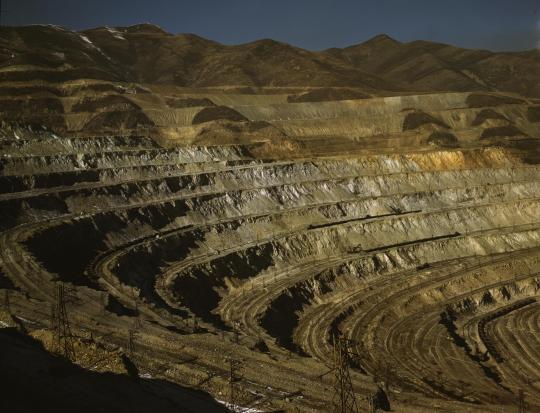
Kennecott Copper Mine, Utah
30 notes
·
View notes
Text
Discover Kennicott Glacier Lodge: An Alaskan Hidden Gem
Don't miss this serene getaway in the stunning Alaskan wilderness!
Get ready for an incredible adventure at Kennicott Glacier Lodge! This unique and storied hotel overlooks Root Glacier in Alaska’s Wrangell St. Elias National Park. It’s not just a place to stay – it’s a gateway to stunning landscapes and extraordinary experiences. Kennicott Glacier Lodge: Getting There This extraordinary lodge finds its home in the historic mining town of Kennicott. It is…

View On WordPress
0 notes
Text

Key point hiding in the tags. A fully electric energy grid to replace fossil fuels needs a breathtaking amount of metal. So, reconciling that AND environmental/pollution/land rights concerns crucial.

The Bingham Canyon Mine is an open-pit mine in Salt Lake City, Utah. At 2.5 miles (4 km) wide and 0.75 miles (1.2 km) deep, it is the largest man made excavation in the world. It is also considered to have produced more copper than any other mine in history – more than 17,000,000 tons.
40.523000°, -112.151000°
Source imagery: Maxar
306 notes
·
View notes
Text

The view to Kennecott Copper Mine from Riverton Utah
#Kennecott Copper Mine#Bingham copper mine#utah#Oquirrh Mountains#neighborhood#house#good memories#mine
0 notes
Text

Kennecott Mines, McCarthy, Alaska, USA
Patrick Federi
#Kennecott Mines#McCarthy#Alaska#USA#US#United States#United States of America#North America#AKArchitecture
1 note
·
View note
Text
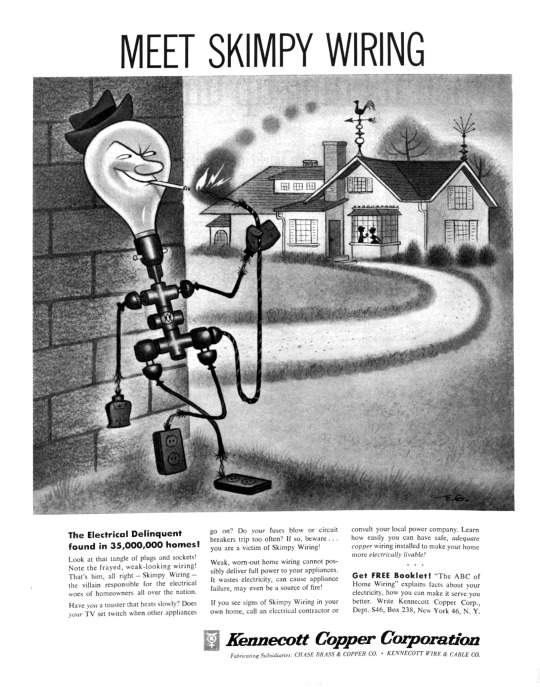
Meet Skimpy Wiring, 1956 ad for Kennecott Copper Corporation
#1956#1950s#vintage#ad#ads#advertising#advertisement#vintage ad#vintage ads#vintage advertising#vintage advertisement
496 notes
·
View notes
Text
Monday Musings: Where does copper come from?
First, native copper (pure copper) is incredibly rare so when you hear about copper mines, it is not native copper that is being referred to. Instead, copper ore is mined.
What is an ore you ask? An ore is a naturally occurring solid material from which a metal or valuable mineral can be profitably extracted.
For copper, the most important ore rocks are chalcopyrite,

Bornite,

and malachite.

Over 50% of the world's copper comes from the first two ores. How are these ores produced in the first place?
Chalcopyrite forms in several different ways. One way is through volcanic-associated hydrothermal events in submarine environments. In modern terms, we call these black smokers. There's a lot more I could say on this but I don't want to turn this into a mile long post.

Another source is sedimentary exhalative deposits. These also occur in the ocean when salt water leaches metals out of clastic sedimentary rocks.

Yet another source is Kambalda type komatiitic nickel ore deposits where is forms from an immiscible sulfide liquid in sulfide-saturated ultramafic rocks. In this case chalcopyrite is more of an accessory mineral.

Bornite, also known as peacock ore because it's flippin gorgeous,

Like chalcopyrite, it can form through hydrothermal precipitation. It can also occur with pegmatites (igneous rocks with very large crystals),

contact metamorphism,

and cupriferous shales (copper-rich).

The largest source of copper ore is Chile with the U.S. coming in second. The largest copper mine in the States is Bingham Canyon Mine better known as the Kennecott Mine. I actually work fairly close to this mine.

Another, former, copper mine I am fairly familiar with is the Berkeley Pit in Butte, MT. This mine is a nasty mess and has killed a large number of snow geese due to its high acidity. Currently, there is a type of protozoan that has adapted to the harsh conditions of the pit. This is a lesson in cleaning up mining operations properly when they are completed.

So, in conclusion, copper ores are associated with volcanism to one extent or another. So, if you want to find copper minerals or like start your own copper mine, make sure you look for sulfide deposits near volcanic rocks.
Tune in tomorrow for some more copper trivia! Fossilize you later!
68 notes
·
View notes
Text
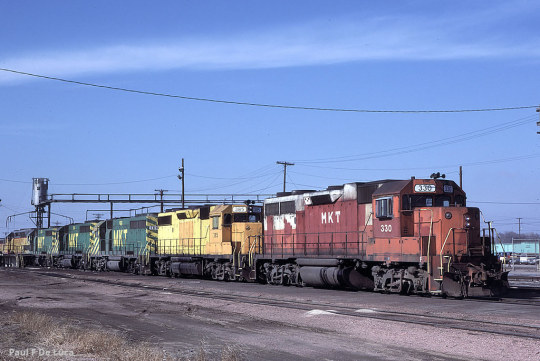
MKT 330, Council Bluffs, IA
Katy grain train power lays over at Union Pacific's Council Bluffs service track. When the MKT picked up Rock Island's OKT trackage they went on a used locomotive buying spree which included GP's from ICG, CR, and KCC. MKT330, a GP38AC, and the ex Kennecott Copper GP39-2 (one of 8) were part of that acquisition.
The MKT trackage rights to Council Bluffs were concessions granted to the Katy as part of the UP/MP/WP 1982 merger. With the purchase of the MKT by UP, the Council Bluffs-KC trackage rights were granted to the KCS, who operates over a circuitous BNSF route instead of the UP to reach Council Bluffs. Those rights now have rolled over to CP Rail.
3-1-87
#mkt#missouri kansas texas#icg#illinois central gulf#up#union pacific#1987#trains#freight train#history#council bluffs#iowa
21 notes
·
View notes
Text
Gripping Guilt Wants to Dance (stoned)
I got incredibly stoned and listened to gripping guilt wants to dance in its entirety for the first time ever and just made notes on whatever popped into my head while listening to each song. just because.
don't look to me - i love music that makes me feel like im under water. this feels like a self-help tape. its giving basketball. sports movie monologue. i think im listening to a bryan cox heat death of the universe documentary. what sort of cosmic space montage is these.
love your mind - im so sorry this just sounds like its been taken direct from cabaret night at the cosmic lounge. there's something so similar to Glad You're Alive and it's throwing me off so badly. incredibly beautiful but also jesus.
lucky boy - only one of the songs on this album i listen to regularly, so unfortunately you don't get the joy of my unfiltered reaction. this song remains a perfect depiction of my gender. and my life (i have a very specific interpretation of this song and an associated MV that lives in my brain)
pacesetter - oh we're a pirate. or a blue whale, perhaps. this feels like if britpop went to hell. that's not tim's real voice surely. this feels like a great moment to admit i have no idea what's going on in any of these songs, in my head tim is just singing a series of unrelated words. tim this is horrendous and i adore it for reasons i cannot explain. oh and the whale is back. excellent.
the eventual - we are in high school musical. or danganronpa. which, like, same thing really. now we're in an alien movie. i don't think this song has any actual lyrics.
more time - this feels like a villain song. why do all of these songs make me feel like i'm either at sea or in space. why is this so emotional. i spent so much time rewinding and listening to the "gangway"'s because that one word holds so much character and aaaaaa tim meredith /pos
Regret Me Not - this feels like sparkbird. i am a medieval tavern boy. this should be in how to train your dragon. genuinely this is an incredible song. i may have to buy this album. i cannot tell whether this song is meant to be happy or depressing. i don't think tim knows either.
never loved - i think this song has just given me a headache. indie song voicemail ass. "I hope the ground will open up, swallow us both into a place where our hopes have all become truths" TIM MEREDITH. i shouldn't adore this but i really really do.
exquisitely bad - tim buddy are you okay. its nice to know that even in songs that aren't improvised, i can be so blindsided by the direction that tim takes things in. i feel it worth saying again. tim are you okay.
breaking - once again we are in space. how does tim make stuff like horny for greece and then make genuinely haunting things like this as well.
what it says about me - oh this is so pretty. nvm. woah okay drums hello. oh i like this. billy joel come get some of this. oh this is stunning stunning. just had a religious experience real quick. the lyricism in this song is my favourite thing ever. it sounds like it would be a minecraft parody
the aftermath - oh this is the kind of song they'd have put in some sort of pick your path video game in 2014. like at a really big character moment. this actually might be from the life is strange soundtrack.
falling away - noir. pov you are about to be shot dead in an alley outside a nightclub in the 40s by a man in a monochrome suit. we are in a jazz club in a bad spy novel and im trying to goad you into shooting the man across the bar dead by ordering my martini in a short glass. or something. we might be in the death of a bachelor music video.
unremarkable sin - can't lie, this one isn't doing it for me. alas. its fine, it's just. unremarkable. i guess. i think im just so stoned i'm missing the point of it, unfortunately.
kennecott - this is a fall out boy song. now we're at a d&b rave in ten mill lane. my street dance teacher would have ate this shit up.
on notice - this is a slay. i feel like im probably about to be eaten by a dystopian megacorporation. pov i am trexel geistman and hartro is coming for my ass.
deep air - okay this time we are literally in space its not just me. this is an audio recording of the apollo 15 mission just set to music. they need to get tim to create soundtracks for things.
an imagined sense - we are at the ugly bug ball. this is a soundcloud rapper. this might be the hamilton polka. white boy raging against the system core.
can't happen here - tim meredith creating the title song for the next bond movie not clickbait. we are in the zombie apocalypse. songs taken directly from car adverts.
walk away - and we have looped back around to the self-help tape. gym girl podcast about ending things with your lesbian situationship. in the middle of the night do you go walking in your sleep. from the mountains of faith to the river so deep.
2 notes
·
View notes
Video
NNRY 109 in shop area, Ely, Nevada por Jim Pearson Por Flickr: Nevada Northern Railway brakeman Nick Scheresky signals to the engineer on locomotive 109 to go ahead and clear the switch, as they head back toward the engine house at Ely, Nevada on February 11th, 2022. Locomotive #109 Alco RS-3 built in 1950, 78426, 1800 (1200) hp, 1370 produced. It was bought new by Kennecott in November of 1950 for EX-Ray Mines but was never delivered to them. It was sent to Kennecott Copper Corp and was later sold to LA Department of Water and Power and now is in service at the Nevada Northern. According to Wikipedia: “The Nevada Northern Railway Museum is a railroad museum and heritage railroad located in Ely, Nevada and operated by a historic foundation dedicated to the preservation of the Nevada Northern Railway. Tech Info: Nikon D800, RAW, Sigma 150-600 @ 280mm, f/5.6, 1/800, ISO 360. #trainphotography #railroadphotography #trains #railways #jimpearsonphotography #trainphotographer #railroadphotographer #steamtrains #nevadanorthernrailway
8 notes
·
View notes
Text
so long, we become the flowers - Cowboy AU - Fic Beginning Meta
So, "we become the flowers", a.k.a. my cowboy au is finally out and being worked on! I'm super excited to be posting this. I'm delighted to have gotten it done already as I was hoping to have it posted before the 17th to celebrate the RDR re-port hahah. I got lucky!
Here is a link to the fic midpoint meta, posted along with chapter 5!
Here is a link to the post-fic meta, posted after the fic was completed!
-
General thoughts
This fic is meant to be a western style of story, and as such I wanted to follow one of the three western storylines (bounty hunting, revenge, and political stories). I chose revenge! Bounty hunting is technically in there too, but I’d call this more of a revenge story than one about picking up a bounty.
I kind of blended this Western revenge genre with Austen-style romance because ooughh,,, the romantic and homoerotic tension in wanting someone SO BADLY but not being allowed to make a move for fear of scandal… it’s tasty stuff.
The au is meant to be set in a fantasy alternate - real-world in many ways, but flowers can bloom whenever I feel like it because I want cute flowers throughout the fic. I wanted an early-spring discussion in the beginning of this fic, but Fade gives her a peony, which bloom starting from late spring.
The town was named Vennecoate both as a reference to Venice and also to Bloodwritten Silver. I chose Venice as the inspiration behind Venshire in that fic and I liked the reasoning well enough to do the same here - that reasoning being Venice is both a huge part of Valorant lore and also where the training range is. I just like it! I chose this specific naming style after a real old western town, too - Kennecott in Alaska, which was a mining camp abandoned after natural resources dried up in 1938. It’s a national historic landmark now and can be visited.
Fade and Neon are called Hazal and Tala in this au, but like I did with bloodwritten silver, I’ll be calling them and other named characters by their codenames just for my own sake in meta posts.
Neon’s dog is called Kidlat which means lightning… bc “lightning strike”… she has Lightning and Strike… I’ll go now
-
Moodboards
I made mood boards for Fade and Neon’s rough looks, as well as examples of their horses with their counterparts in RDR2. I also have Sims of them and their horses which I’ve shared before!

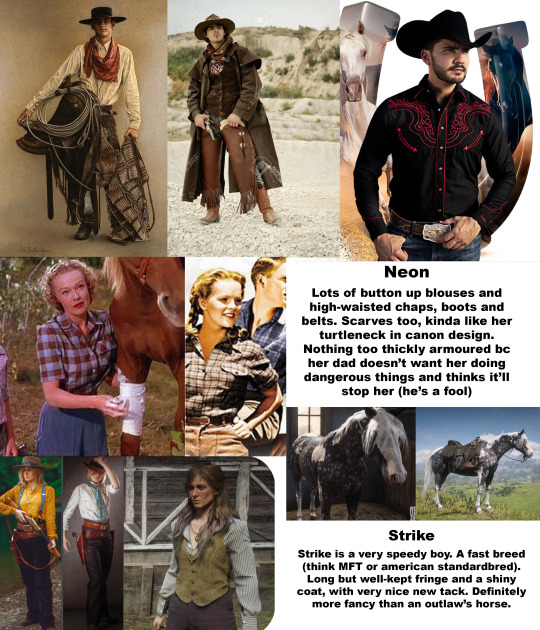
I’ve made more moodboards for this fic, but those are spoilers which I’ll only show in the fic ending meta…
Someone on Discord actually drew these guys too, and they managed to NAIL the exact vibe I was going for without ever even seeing the moodboards. Huge shoutout to WissyDumb / wizzul on discord! Sharing these with their permission of course.
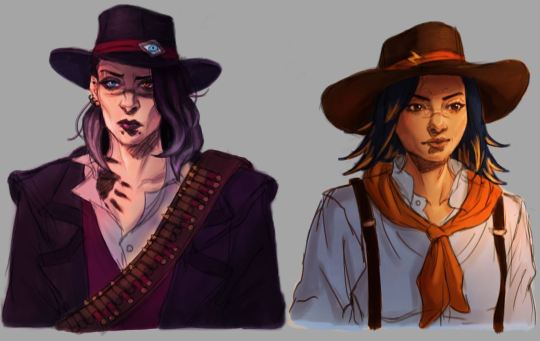
They don’t have their piercings in the fic (piercings wouldn’t become commonly used until around the 1950s) and Fade actually has some trauma related to infection and disease (we’ll learn more about this later), so she wouldn’t risk it even if they were commonly worn at this time.
-
Playlist
I have a playlist for this fic of course, as I do with all of my larger projects. I imagine this will continue to grow as I work on the fic but I'll share the songs on there so far!
In A Week - Hozier (where the fic's title comes from)
Throne - Saint Mesa
Beautiful Crime - Tamer
Mausoleum - Rafferty
notre dame - Paris Paloma
Habibi - Tamino
Setting Sun - Lord Huron
The Night We Met - Lord Huron
You're Gonna Go Far, Kid - The Offspring
Dangerous Woman - Ariana Grande
the fruits - Paris Paloma
labour - Paris Paloma
Stacy's Mom - Fountains of Wayne
Eyes on Fire - Blue Foundation
Hey, Little Songbird - Hadestown
She - dodie
Let Me In - Snowmine
Coyotes - Modest Mouse
Can't Help Falling in Love - Haley Reinhart
The Wolf - PHILDEL
Hand of God - Outro - Jon Bellion
Breathe (In The Air) - Pink Floyd
The Great Gig in the Sky - Pink Floyd
Family of Me - Ben Folds
All Along the Watchtower - Bear McCreary
My Name is Carnival - Stranded Horse
Requiem on Water - Imperial Mammoth
Short Change Hero - The Heavy
Little Girl Gone - CHINCHILLA
I Wish A Bitch Would - Delilah Bon
One of Us - The Lion King 2: Simba's Pride
No Surprises - Radiohead
Something About Us - Daft Punk
Please, Please, Please, Let Me Get What I Want - The Smiths
Creep - Radiohead
Nights in White Satin - The Moody Blues
Blood In The Wine - AURORA
Rawhide - Frankie Laine (hahah)
I See Red - Everybody Loves an Outlaw
House of The Rising Sun - Five Finger Death Punch
The Yawning Grave - Lord Huron
Burn The Witch - Shawn James
Grow as We Go - Ben Platt
Spectre - Radiohead
Long Long Time - Linda Ronstadt
Arsonist's Lullabye - Hozier
Pretty Little Head - Eliza Rickman
Never Love an Anchor - The Crane Wives
That Unwanted Animal - The Amazing Devil
Cowboy Casanova - Carrie Underwood
What Makes A Good Man? - The Heavy
Asleep - The Smiths
The Everlasting Muse - Belle and Sebastian
Layla - Derek & the Dominos
Senden Daha Güzel - Duman
Resistance - Muse
We Could Be The Same - Istanbul - maNga
Last Flowers - Radiohead
Man of War - Radiohead
WHEWW this is a long one. Sorry!
9 notes
·
View notes
Text
49th State Brewing takes home World's Best Nitro at this year's European Beer Star Awards.

Press Release
Forbes released the list of the World’s Best Stouts and 49th State Brewing represented Alaska among the world's best with Nitro McCarthy Stout. In 2024, the European Beer Star had 2,360 entries from 50 countries. Of that pool, 225 medals were awarded. The beers were judged by an international panel of experts during a blind tasting at the Exhibition Center in Nuremberg, Germany.
Before founding 49th State Brewing, David McCarthy was an avid homebrewer. A fan of Guinness, McCarthy developed his own dry Irish stout recipe with similar drinkability but more robust flavors and aromas of chocolate, coffee, and dark roasted malts.
When 49th State Brewing opened in 2010, this stout was the first beer produced. Named for the town of McCarthy where Irish pioneer, James McCarthy, settled during the Klondike Gold Rush next to the Kennecott mine, this beer carries the tradition of supplying beer to miners and community members alike.
In 2021, 49th State became the only brewery in Alaska producing beer in a nitro widget can. It’s fitting that Nitro McCarthy Stout should be named one of the best in the world as 49th State enters its 15th year of operations. A favorite of the Irish Club of Alaska and stout lovers around the state, Nitro McCarthy Stout will be flowing at the largest St. Patrick’s Day celebration in the state held at their downtown Anchorage pub.
Also showcasing Alaska’s craft beer quality, 49th State’s Smо̄k Lager won its 2nd European Beer Star medal this year in the Franconian-Style Smoke Beer category.
49th State Brewing - Anchorage
At 49th State Brewing - Anchorage, cultural layers of Alaska unfold around you. Delve into the long tradition of brewing with award winning beer, explore a menu with freshly sourced Alaskan products, and relax on the rooftop patio overlooking the Cook Inlet and Alaska Range. More than a brewpub, 49th State is a community center. A canine-friendly meal can be enjoyed in the beer garden that boasts the Dogs of 49th State Dog Park. And with the array of event spaces hosting concerts, seminars, conferences, and weddings, 49th State Brewing is the dynamic, can’t-miss component to the downtown Anchorage experience.
1 note
·
View note
Text
Terre rare e materie prime critiche in Italia

Dove sono i metalli rari in Italia. Se lo sta chiedendo il governo, che ha approvato un decreto per sfruttare vecchi giacimenti e aprire nuove miniere. Dopo le sollecitazioni ricevute negli ultimi anni dall’Unione Europea, lo scorso 20 giugno il governo italiano ha approvato un decreto per sostenere la ricerca delle cosiddette “materie prime critiche”, un gruppo di metalli particolarmente necessari per il settore tecnologico e per la transizione energetica. Le materie prime critiche servono soprattutto all’industria dei microchip e dei componenti elettronici o per la produzione di batterie dei veicoli elettrici. Alcune hanno nomi più conosciuti, come il rame, il litio, il silicio e il nichel, altre sono meno note come il bismuto, il boro, il cobalto, il gallio, il germanio, il magnesio e il manganese, la grafite naturale, il titanio e il tungsteno. Fino a qualche decennio fa in Italia c’erano diversi giacimenti di questi metalli, miniere via via abbandonate perché dai costi insostenibili soprattutto se paragonati a quelli delle importazioni. Tuttavia negli ultimi anni l’aumento della richiesta dei metalli rari ha invertito questo rapporto: ora comprarli all’estero e importarli è molto costoso, mentre è più vantaggioso e politicamente strategico sfruttare vecchi giacimenti o trovarne di nuovi.

Ore is hauled from the Kennecott's Bingham Canyon Copper Mine Wednesday, May 11, 2022, in Herriman, Utah. Rio Tinto is now producing a rare and critical mineral that is used to make solar panels. Tellurium was essentially thrown out in mine tailings for decades after ore mined from the mountains was turned into copper. It is listed as a “critical mineral” by the U.S. government. Most of the tellurium produced comes from China and other countries. (AP Photo/Rick Bowmer) Con queste premesse il governo ha approvato una serie di misure: semplificare le procedure per consentire alle compagnie minerarie di cercare nuovi giacimenti, finanziare una mappatura più completa delle aree sulla base di studi geologici, realizzare un piano nazionale delle materie prime con una definizione più puntuale dei finanziamenti per questo settore. L’obiettivo è spingere le compagnie a investire nella ricerca di nuovi giacimenti. Il ministro dell’Ambiente e della Sicurezza energetica, Gilberto Pichetto Fratin, ha detto che il programma esplorativo dovrà essere pronto entro il 24 maggio 2025. Se ne occuperà l’ISPRA, l’istituto superiore per la protezione e la ricerca ambientale, a cui sono stati dati 3,5 milioni di euro per realizzare una mappa dei possibili giacimenti, la nuova carta mineraria dell’Italia. Grazie alla nuova carta potranno essere aggiornati e migliorati i censimenti fatti dall’ISPRA negli ultimi anni. Uno degli ultimi censimenti è stato pubblicato nell’atlante dei dati ambientali, aggiornato al 2023, e comprende i giacimenti sfruttati in passato e ora da rivalutare.

I giacimenti italiani di materie prime critiche Nel documento dell’ISPRA si legge che l’Italia è «totalmente dipendente» dai mercati esteri, ma anche che sul territorio esistono mille possibili giacimenti: i più interessanti sono nell’arco alpino, in Liguria, nella fascia tirrenica tra Toscana e Campania, in Calabria e in Sardegna. «La coltivazione di minerali metalliferi è stata progressivamente abbandonata a cavallo dei due secoli non per esaurimento delle risorse ma, nella quasi totalità, per le convenienti condizioni economiche dei mercati esteri delle materie prime e per la mancanza di lungimiranza della politica industriale mineraria», dice lo studio. Risultano attive soltanto due miniere di fluorite (a Bracciano, in provincia di Roma, e a Silius, in Sardegna) e una ventina di feldspato tra Piemonte, Toscana, Lazio, Calabria e Sardegna. C’è poi un giacimento di titanio in Liguria, uno di cobalto in Piemonte e uno di litio in Lazio. Negli ultimi anni sono stati dati permessi per cercare zinco, cobalto, titanio e nichel in particolare sull’arco alpino. Il decreto prevede anche che le compagnie minerarie titolari delle concessioni, già attive o future, dovranno dare allo Stato tra il 5 e il 7 per cento dei prodotti estratti. Questa sorta di tassa finanzierà il fondo nazionale del Made in Italy per sostenere nuovi investimenti e un’ulteriore ricerca di materie prime critiche. In merito all’impatto ambientale, su cui c’è una maggiore sensibilità rispetto al passato, il governo ha incaricato l’ISPRA di vigilare sui progetti di ricerca dei metalli insieme alle soprintendenze dei territori interessati. L’ISPRA potrà bloccare i permessi se verranno rilevate irregolarità, per esempio trivellazioni in punti non consentiti. L’istituto dovrà anche coinvolgere gli enti locali, in particolare i comuni, per spiegare in modo approfondito i lavori previsti, l’impatto delle ricerche e dell’eventuale apertura di nuove miniere. Read the full article
0 notes


